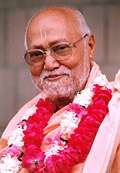Bhakti Ballabh Tirtha
| Bhakti Ballabh Tirtha | |
|---|---|
 Bhakti Ballabh Tirtha | |
| Education | M.A. Philosophy, Calcutta University (1946) |
| Personal | |
| Nationality | Indian |
| Born |
Kamakhya Charan Guharay (Birth Name) 13 April 1924 Goalpara, Assam, India |
| Senior posting | |
| Predecessor | Bhakti Dayita Madhava Goswami Maharaj |
| Religious career | |
| Teacher | Bhakti Dayita Madhava Goswami Maharaj |
| Works | See Publications section |
| Initiation | Diksa–1947, Sannyasa–1961 |
| Post | President of Sree Chaitanya Gaudiya Math, President of WVA |
| Website | http://www.sreecgmath.org/ |
| Part of a series on |
| Vaishnavism |
|---|
 |
|
Sampradayas |
|
Philosophers–acharyas |
|
Related traditions |
|
|
| Part of a series on | ||
| Hindu philosophy | ||
|---|---|---|
 | ||
| Orthodox schools | ||
|
|
||
| Śramaṇic schools | ||
|
|
||
|
||
Srila Bhakti Ballabh Tirtha Maharaj is a grand disciple of Bhaktisiddhanta Sarasvati Thakura and a guru in the Gaudiya Math following the philosophy of the Bhakti marg, specifically of Caitanya Mahaprabhu and Gaudiya Vaishnava theology. He is the current President of Sree Chaitanya Gaudiya Math, headquartered at Kolkata, West Bengal, India and having more than 22 branches in India.[1]
He has written extensively in Bengali, Hindi and English. His most read and referenced book is Sri Caitanya and His Associates, which details the lives of an entire lineage of Gaudiya Vaishnava spiritual leaders, from the 10th century to the present day.
Early life
He was born on 13 April 1924, on the day of Ram Navami, in Goalpara, Assam, India.[2] He is a disciple of Srila Bhakti Dayita Madhava Goswami Maharaj who founded Sree Chaitanya Gaudiya Math in 1953. He was appointed as the president for Sree Chaitanya Gaudiya Math in 1979. He also serves as the president of the World Vaishnava Association (WVA).[3]
He has been travelling around the world and spreading the teachings of Caitanya Mahaprabhu around the world.[4] He is among the most read master in the speaking tree initiative of The Times of India.[5]
Publications[6]
One of the major contributions of Srila Bhakti Ballabh Tirtha Maharaj has been the books authored by him. His books are based on Vedic scriptures and are clear reflections of the teachings of Chaitanya Mahaprabhu and of Gaudiya Vaishnavism. Below is the list of his books:
- Sri Chaitanya: His Life and Associates ( ISBN 978-1886069282) This book describes the lives of an entire lineage of Vaishnava spiritual leaders, from the 10th century to the present day.
- Dasavatara (ISBN 1932771824) This is an in-depth commentary on the divine pastimes of Ten Manifestations of Sri Vishnu, described in Gita Govinda, composed by Jayadeva Goswami.
- Sages of ancient India (ISBN 1886069581) This book is the English rendering of the stories of Dhruva and Prahlada. These two famous Indian stories, one of a thwarted prince seeking redemption and other of a saintly boy born to a demon king, provide inspiration for overcoming difficulties on the spiritual path.
- A Taste of Transcendence (ISBN 1886069719) This is a collection of English discourses delivered by Bhakti Ballabh Tirtha between 1997 and 2000 in the US, Europe and India. These sublime lectures encapsulate, in the form of colorful stories, insightful analogies and lucid commentary, the essence of the teachings of Sri Chaitanya Mahaprabhu and the devotee saints of ancient India.
- Sudha Bhakti (ISBN 1886069360) This book explains the path of pure devotion.
- Affectionately Yours-Divine Letters This book is an extensive collection of letters (1981-2012) written by Bhakti Ballabh Tirtha to his disciples as a response to their spiritual inquiries.
- Sages, Saints and Kings of Ancient India This book is a compilation of pastimes of legendary personalities from Vedic Scriptures such as Bhagavata Purana, Mahabharata and Ramayana.
- Harikatha And Vaishnava Aparadha
- Nectar Of Harikatha
- Path of Pure Devotion
Footnotes
References
- Chopra, Swati (2003), "The Way of Love", Life Positive, vol. 11
- Broo, Måns (2003), As good as God: the guru in Gauḍīya Vaiṣṇavism (PDF), Åbo Akademi University Pres, ISBN 951-765-132-5
- Gupta, Dr. Ravi M (2014), Caitanya Vaisnava Philosophy: Tradition, Reason and Devotion, Ashgate Publishing, Ltd
- Melton, J. Gordon (2014), Religions of the World: A Comprehensive Encyclopedia of Beliefs and Practices, 2nd Edition [6 volumes]: A Comprehensive Encyclopedia of Beliefs and Practices
- "'Absolute truth is eternal'", The Times of India, p. 2, March 6, 2012
External links
- http://trove.nla.gov.au/result?q=creator%3A%22Bhakti+Ballabha+Ti%CC%84rtha.%22
- http://www.nineislandspress.org/A-Life-Of-Devotion/
- http://www.spiritualbangalore.com/why-we-need-to-remember-god-by-b-b-tirtha-maharaj-president-all-india-sree-chaitanya-gaudiya-math/
- http://www.wva-vvrs.org/pbook/pkb16.htm
- http://www.gokul.org.uk/
- http://www.bvml.org/SBBTM/
- http://vanisource.org/wiki/750902_-_Letter_to_Bhakti_Ballabh_Tirtha_written_from_Vrndavana
- http://oldchakra.com/2002/03/24/tkg.by.bhakti.ballabh.tirtha.sw/print.htm
- http://vaishnava-news-network.org/world/WD0204/WD24-7283.html
Further reading
- https://web.archive.org/web/20160419031717/http://www.trilokanath.com/Gokul/Articles/ArticleBBTirthaGita.htm
- http://iskconnews.org/vaishnavism-tarnished-month-of-purushottama-is-celebrated-as-most-holy,112/